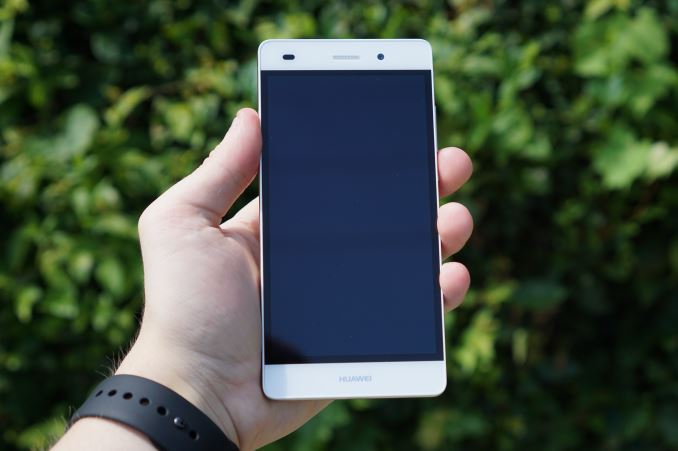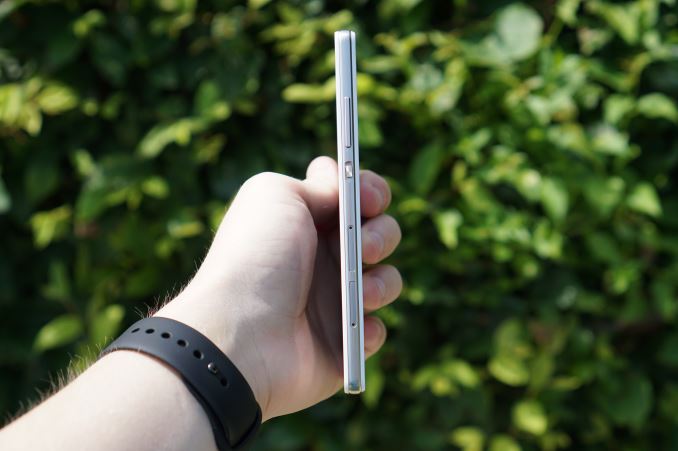The Huawei P8 Lite Review
by Brandon Chester on July 27, 2015 8:00 AM EST- Posted in
- Smartphones
- Huawei
- Mobile

Although many consumers are not familiar with Huawei, they are a company that has been selling smartphones for quite some time now. In the earliest days of the smaller Canadian carriers Huawei was one of the few companies that had smartphones available on their networks due to their use of the AWS band for HSPA which was uncommon in other devices here at the time. While Huawei has always had one or two flagship devices and makes some phablets, to me their core market was always mid range devices. Often these mid range devices are a downsized version of their flagship devices, and the smartphone being reviewed today is no exception. It's the Huawei P8 Lite, and it's the little brother of the Huawei P8.
The P8 Lite is Huawei's device to compete in the mid $200 market. At $249, it's more expensive than a device like the Zenfone 2, but not as expensive as something like the OnePlus One. There are actually two versions of the P8 Lite depending on your market. The first uses HiSilicon's Kirin 620 SoC which has eight Cortex A53 cores at 1.2GHz, while the second uses Qualcomm's Snapdragon 615 SoC. The version being examined during this review is the Qualcomm edition, and you can check out the rest of its specifications in the chart below.
| Huawei P8 Lite | ||||||
| SoC | Qualcomm Snapdragon 615 4x ARM Cortex A53 at 1.5 GHz 4x ARM Cortex A53 at 1.11 GHz Adreno 405 at 550 MHz |
|||||
| Memory and Storage | 2GB LPDDR3 RAM, 16GB NAND + MicroSDXC | |||||
| Display | 5.0" 1280x720 IPS LCD | |||||
| Cellular Connectivity | 2G / 3G / 4G LTE (Qualcomm MDM9x25 IP UE Category 4 LTE) | |||||
| Dimensions | 143 x 70.6 x 7.7 mm, 131g | |||||
| Cameras | 13MP Rear Facing w/ 1.12 µm pixels, 1/3.06" CMOS size, F/2.0, 28mm (35mm effective) 5MP Front Facing, F/2.4, 22mm (35mm effective) |
|||||
| Battery | 2200 mAh (8.36Wh) | |||||
| Other Connectivity | 802.11b/g/n + BT 4.0, GNSS, microUSB 2.0 | |||||
| Operating System | Android 4.4 KitKat With Emotion UI 3.0 | |||||
| SIM | MicroSIM | |||||
| Price | $249 | |||||
On paper, the P8 Lite sits right in the mid range segment of the market. Inside it has Qualcomm's Snapdragon 615 SoC, with two clusters of four Cortex A53 cores and their Adreno 405 GPU. Other internal specs include 2GB of RAM, 16GB of internal storage, an 8.36Wh battery, and 802.11n WiFi. On the outside is the 5" 1280x720 IPS display, and a pair of rear and front cameras with 13MP and 5MP resolutions respectively.
On the software side we see that the P8 Lite is only shipping with Android KitKat skinned with Huawei's Emotion UI. Andrei has already taken a look at the iterations of this interface on a number of occasions, and there's not much I can add to his evaluation of Emotion UI 3.0 from his review of the Ascend Mate 7 so I'll simply link that here for interested readers. The underlying version of Android being KitKat is definitely disappointing when the P8 Lite is being sold in July of 2015 with Android M on the horizon, and it means that the Snapdragon 615 SoC has to run in AArch32 mode. The P8 Lite and all its hardware and software comes together in a 7.7mm thick package that costs $249.
The design of the P8 Lite definitely takes some cues from the larger high end Huawei P8. The front of the phone is remarkably similar, with the same outer white bezel surrounding a black bezel around the display. On the top bezel we have the earpiece, front-facing camera, and the proximity sensor. On the bottom is nothing but Huawei's name, as the P8 Lite uses onscreen navigation buttons. As far as differences from the P8 go, the black bezel around the display is thicker on the left and right sides, and the camera and earpiece have more spacing between them and the earpiece.
While the Huawei P8 has an aluminum chassis, the P8 Lite is very clearly made of plastic. The sides and rear of the phone are significantly different from the P8. To add a bit of flare to the plastic chassis Huawei has added a plastic band that attempts to mimic the appearance of metal. From the side it kind of reminds me of an ice cream sandwich due to the two outer layers of the same color and a different inner layer. Huawei has also put their power button, SIM slot, and microSD slots on the right side in the same fashion as the P8. While some people might like the metal appearance of the outer band, I'm not really a big fan. When making a plastic device you either need to own it and use it to your advantage like Nokia/Microsoft does with their Lumia devices, or you need to make it look very convincing like the back cover of the Zenfone 2. In the P8 Lite's case it still looks very much like plastic, and reminds me of the fake chrome on the bezel of my Galaxy S i9000.
The back of the P8 Lite has two segments. At the top is a glossy thin strip which holds the rear-facing camera and LED flash on the left side. Everything below is a more textured plastic, with horizontal lines running across it. As far as construction goes, there's not really any flex or give to the back cover, and the texture created by the lines makes it feel different in the hand than a device like the Moto E or Moto G.
My opinion of the P8 Lite's design and build quality is somewhat divided. It has a good feel in your hand, and there's no flex or anything that would suggest weakness. On the other hand, I really don't like the faux-metal band around the edge of the phone. Trying to mimic brushed aluminum with plastic is always going to backfire, and I think Huawei would have been better off just making the sides white like the rest of the chassis.












45 Comments
View All Comments
Buk Lau - Wednesday, July 29, 2015 - link
It is capable of QC 2.0, they just don't ship you with a charger and you just have to get it yourself from somewherezebrax2 - Monday, July 27, 2015 - link
Error in the specifications table showing A7 instead of A53.jjj - Monday, July 27, 2015 - link
Disturbing that for a SoC known for it's overheating capabilities (yes this one too), you fully ignore the issue and don't look for throttling."Snapdragon 615 is really the best you're going to get at this price point"
That is clearly a false statement and not sure how can you make it. SD615 is likely the worst A53 based solution in this price range clock for clock and not just in CPU. If you factor in that others are going higher clocks (without overheating) in the same price band and even higher clocks for slightly costlier and more capable SoCs , your statement becomes even more absurd.
But that's when you factor in the SoC price not the device price. If you go by device price, the OnePlus One is 250$ and if you factor in China, a bunch of faster devices are at or very close that price.
T1beriu - Monday, July 27, 2015 - link
Source?jjj - Monday, July 27, 2015 - link
For what? SD615 can't do 1.7GHz and pretty much any device with those clocks is know to have problems. At 1.5GHz it throttles little if at all but that can depend on the device and requires investigation. As for how it does against competing 8xA53 SoCs from Hisilicon (hey those are actually worse), Marvell, Mediatek and Samsung it would take some time(that i don't have) to find a bunch of reasonably good links since too many can't be bothered to look beyond Qualcomm, just like AT loves to do.djw39 - Monday, July 27, 2015 - link
How can you say the Snapdragon 615 is "likely the worst A53 based solution in this price range" then?LiverpoolFC5903 - Tuesday, July 28, 2015 - link
The MTK 6752 is significantly faster than the SD 615 and runs cooler too, despite all the ores being clocked at a relatively high 1.7ghzThe 615 flatters to deceive and is hamstrung by memory bandwith issues and thermals. If they had provided a dual channel 32 bit RAM like the older Snapdragon 600 and paired it with the Adreno 320, it would have been a killer mid range chip. Alas,this is par for the course these days with Qualcom chipsets.
One more observation, the Zenfone 2 is absolutely suberb in terms of performance/price/ Nothing else in the midrange comes close to it in terms of both CPU and GPU performance. The 2.3 GHZ and 4 GB model at 300 USD performs as good as any Snapdragon 801 device and trades blows with the 805.
AndrewJacksonZA - Tuesday, July 28, 2015 - link
Totally off topic, so apologies in advance, but..."T1beriu" as your nick? Is it meant to be in reference to the Tiber River? Tiberius Caesar? Tiberium? Brigadier General Mark Jamison Sheppard must know! :-)
twizzlebizzle22 - Monday, July 27, 2015 - link
What's the benefit of using big little with the same core architecture between the clusters.Can't one cluster scale back under lighter workloads?
cmikeh2 - Monday, July 27, 2015 - link
You can fab the transistors for the two different clusters differently. For the high performance cluster, you would use a higher leakage, faster transistor (and power gate when not in use) and for the low power cluster use slower, but lower leakage transistors.